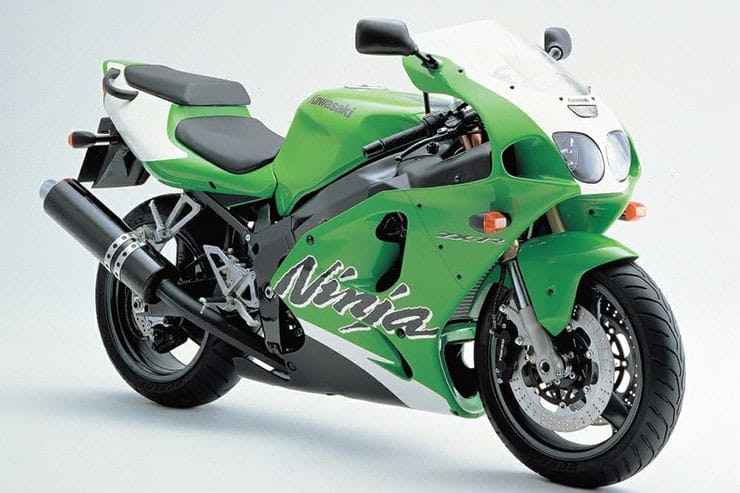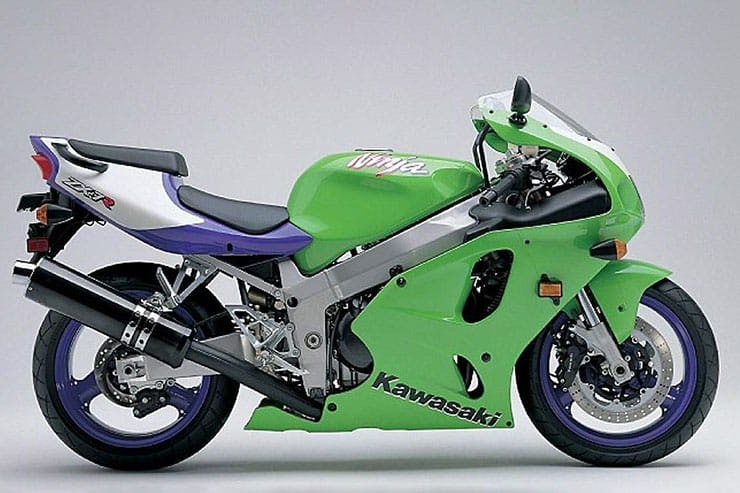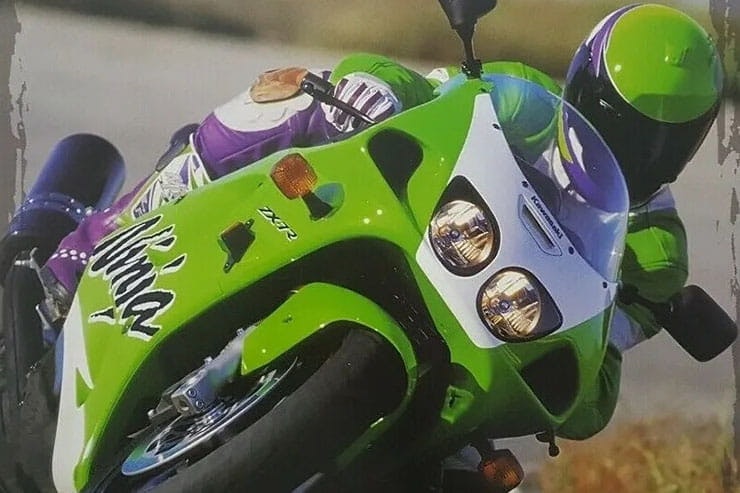Kawasaki ZX-7R (1996-2002): Review & Buying Guide
By Jim Moore
Bike journo for a quarter of a century
09.02.2024
Price: £2500-£5000 | Power: 111bhp | Weight: 203.4kg | Overall BikeSocial Rating: 4/5
The World Superbikes Championship made huge waves during the mid-’90s, drawing bigger crowds and more interest in certain countries, like the UK, than GP racing. For the manufacturers involved, winning on a Sunday really did sell bikes on a Monday, leading to a boom in sales of sportsbikes – and superbikes in particular.
Kawasaki won the 1993 WSB title, with American Scott Russell taking the crown aboard his Muzzy prepared ZXR750. But by then the ZXR was nearing the end of its useful life. A new model was required if Kawasaki was to stay competitive in WSB, and the 1996 ZX-7R was that machine.
The 7R’s basic recipe was very similar to that of the outgoing ZXR – a 750cc, DOHC, 16v inline-four fed by ram-air induction wrapped in an aluminium twin-spar chassis. But the ZX-7 was tweaked in every area to make it sharper for the track action as well as more suited to road use. Two models appeared, the road-going ZX-7R and track-focussed ZX-7RR, both of which proved popular and successful at their specific disciplines.
Nostalgic interest in 1990s WSB racing (considered by many as the series’ golden period) has put bikes like the ZX-7R back on the map. That and the fact they’re a completely different proposition to modern, 200bhp, electronically aided superbikes. The ZX-7R is a product of an analogue age, before traction control, ABS, wheelie control and riding modes. Just pure, undiluted thrills. That and its aggressive yet timeless style make the 7R an irresistible modern classic.
Kawasaki ZX-7R (1996-2002) Price
1996 Kawasaki ZX-7R P1: First ZX-7R, replacement to the previous ZXR750 (confusingly, American market ZXRs were known as ZX-7s, so the name change was clearer in Europe than across the pond). Distinctive twin ram air intakes on the front of the fairing. Twin spar aluminium chassis. 748cc, 112bhp, 203.4kg. Two-tone colours. Colours: green/purple, red/purple
1996 Kawasaki ZX-7RR N1: Limited edition homologation model. Adjustable swingarm pivot and steering angle, aluminium fuel tank, single seat, 41mm Keihin FCR carbs, close-ratio gearbox, 6-pot Nissin calipers, 122bhp@12,000rpm, 200kg. Colours: green/purple
1997 Kawasaki ZX-7R P2: No technical changes; only the addition of an all-black colour option. Colours: green/purple, red/purple, black
1998 Kawasaki ZX-7R P3: Large Ninja logo on the fairing. Colours: green/purple, red, black
1999 Kawasaki ZX-7R P4: Colour updates, plus a change in chassis colour to black. Colours: red/white/black, silver/black
2000 Kawasaki ZX-7R P5: Colours the same as the P4, but a change from Ninja logo on the side of the fairing to ‘Kawasaki’. Colours: red/white/black, silver/black
2001 Kawasaki ZX-7R P6: No changes. Colours: green/black/white, red/white/black
2002 Kawasaki ZX-7R P7: Final model, tweak to graphics. Colours: green/white/black
Values are based more on condition, mileage and originality than year of manufacturer. RR models are rare – prices are purely a guide; collectors may pay more for the right bike.
Kawasaki ZX-7R values:
Rough: £1500-£2000
Tidy: £2500-£4000
Mint: £4500-£5000
Kawasaki ZX-7RR values:
Rough: £7000-£8000
Tidy: £9000-£12,000
Mint: £14,000-£18,000
Still the best looking 750 superbike of the 1990s
Amazing front end feel
Great value for 160mph performance
Rotten downpipes and general corrosion
Lumpy fuelling when carbs fall out of balance
Lacks the oomph of SRAD GSX-Rs
Kawasaki ZX-7R (1996-2002) Engine and Performance
The ZX-7R’s engine was nothing new. Kawasaki has long preferred evolution to revolution, choosing to wring the maximum out of proven technology before starting again from scratch. The 7R’s inline-four engine can trace its roots back to the 1987 GPX750R and through the following ZXR750s, sharing much of its DOHC 16v architecture with those earlier models.
There were differences, however. Kawasaki changed the bore and stroke from 71 x 47.3mm to 73 x 44.7mm to boost midrange and torque (up from 54.3lb.ft on the ZXR750L to 55.6lb.ft). This shorter stroke arrangement also allowed greater valve surface area and a broader squish for improved combustion. A lighter flywheel combined with the shorter stroke created a quicker revving unit than the old ZXR. Top end power was reduced fractionally from a claimed 118 to 112bhp, but aerodynamic improvements kept the 7R’s top speed north of 160mph.
Fuelling is down to a bank of 38mm Keihin CVKD carbs. Performance is further boosted by a ram air system feeding cool air from two fairing scoops into the pressurised airbox (the ZXR-L featured a single air feed). The homologation RR model runs 41mm flatslide carbs and a close ratio gearbox.
While the ZX-7R’s 112bhp output is rather tame by today’s standards, Kawasaki has always tried to make its sportsbikes work on road as well as track. There’s enough midrange on tap to haul tarmac at a respectable pace, plus an addictive howl at high rpm (peak power is at 11,700rpm) from the ram air system.
Kawasaki ZX-7R (1996-2002) Handling & Suspension
Like its engine, the ZX-7R’s chassis was also evolution of the outgoing ZXR’s technology. An aluminium twin-spar frame holds everything in place (the RR model features an adjustable swingarm pivot and headstock to aid racetrack set-up). And there was never anything wrong with the ZXR’s steering – Kawasaki’s 750 superbikes had long been lauded for the accuracy, precision, and feedback of their front ends, so the ZX-7R features the same 25°/99mm rake and trail as the older bike.
The ZX-7R’s suspension was overhauled, however, with thicker 43mm, fully-adjustable usd cartridge forks taking care of front end damping (the ZXR750L ran 41mm stanchions), plus a redesigned linkage for the fully adjustable rear shock. Rear tyre size was also increased, from 180 to 190 section – a change that could have caused to stability issues. In order to prevent this, Kawasaki lengthened the wheelbase by 5mm with a longer swingarm.
While ZX-7 handling is stable, solid and dependable – particularly the front end which can be leant on hard, especially on track, the bike’s 203.4kg dry weight is something of a handicap against its competitors – Suzuki’s GSX-R750WT, for example, weighs 25 kilos less, making it more agile and flickable.
Kawasaki ZX-7R (1996-2002) What to look for
Brakes: 6-pot calipers were a ’90s fad and barely an improvement over 4-pots in terms of performance. The ZX-7’s Tokicos are decent when in fine fettle, but they require regular maintenance to be at their best. Rebuilds can be expensive due to the number of pistons and seals. The RR model also uses 6-pots, but higher quality Nissins.
Engine: Solid, reliable, and able to trace its lineage right back to the 1987 GPX750. Cam chain tensioners can fail – mechanical replacements are a popular upgrade. Service intervals are every 4000 miles. Use a quality semi-synthetic oil. Valve clearance need inspection every 12,000 miles. Gearboxes are strong, but test it under load in second to ensure it doesn’t jump out of gear.
Carb icing: Symptoms can range from stuttering to, in extreme cases, a stuck throttle. An anti-icing circuit passing warm coolant from the radiator around the carbs should be fitted on UK bikes (parallel imports were popular during the ’90s, so if a bike was sourced from southern Europe it might not have the anti-icing circuit). Warming the engine throughly before setting off in cold weather helps, as does Silkolene ProFST fuel additive.
Forks: The ZX’s front end feel is legendary, so well maintained forks are essential. Check that none of the adjusters are stuck – they’re fully adjustable. Check the stanchions for pitting, rust and weeping seals.
Shock: ZXR750s suffered from overly stiff rear damping, caused mainly by an incorrect linkage ratio. 7R rear suspension is better, but even late registration examples will by now be over 20 years old, so replacing the OE shock with a quality unit is money well spent.
Exhaust system: The mild steel downpipes and link pipe rot. Even if they look ok from the outside, condensation can corrode the system from the inside, so most ZX-7Rs now wear aftermarket systems. High quality replacement systems such as Akrapovic, Arrow, Micron and Muzzy are best, but carb jetting may need setting to suit.
Plastics: Decent plastics are getting rarer. Fixing tangs and brackets often break, so inspect how the fairing and seat unit fit together. Race style paintjobs can disguise crash damage and not always add value to a bike, unless the work is top quality. Check tanks for rust. Originality and condition always adds value.
Build quality: The ZX-7R’s main components are of decent quality, but the small stuff like bracketry, footpegs hangers and switches can often appear dog-eared. Indicator stalks can snap. The rubber mounts go hard over time and snap off. Replacements can be pricey.
Kawasaki ZX-7R (1996-2002) Rivals
Honda VFR750F, 1996 | Approx Price: £2000-£4200
Power/Torque: 105bhp/53.5lb-ft | Weight: 209kg
Brilliant V4. More of an all-rounder than a pure sports bike. Sophisticated, well made, reliable and still popular. A great choice for two-up riding and touring, but just as adept at turning a weekend into a blast or even the odd trackday. 1994-on RC36 gen 2 model is the best by far.
Suzuki GSX-R750 WT, 1996 | Approx Price: £2500-£4500
Power/Torque: 128bhp/59.3lb-ft | Weight: 179kg
High performance race replica, built around the dimensions of Suzuki’s RGV500 GP bike. With more than 120bhp on tap and sharp handling the SRAD can give a ’90s FireBlade a run for its money and leave a standard ZX-7R in its wake. Condition is everything with an SRAD; go for as standard and tidy spec as possible.
Yamaha YZF750R, 1996 | Approx Price: £2500-£4500
Power/Torque: 125bhp/59.3lb-ft | Weight: 196kg
Older than the ZX-7R, but lighter and a match for the Kawasaki in terms of performance. Still affordable, too, but the OE six-pot calipers are expensive to rebuild, stock suspension will be in need of a rebuild by now, and in terms of style the YZF is a generation behind the sleek ZX-7R.
Kawasaki ZX-7R (1996-2002) Verdict
Time has been kind to many aspects of the ZX-7R. The bike’s distinctive and aggressive styling still packs a significant impact; indeed it’s not hyperbole to say that this 750cc Kawasaki is one of best looking Japanese race reps of its decade.
A ZX-7R can still be exciting to ride, too, even if its power output is modest by modern standards, but the head-down-arse-up riding position is as extreme as it ever was. Comfortable, a ZX-7R is not. But for occasional weekend blasts, the odd trackday, and for the sheer joy of seeing it in the garage every time you open the door, Kawasaki’s ZX-7R still rates highly. Add to that the fact they’re still temptingly affordable – and values will only go one way – and this modern classic superbike is a deserved inclusion on anyone’s ‘want’ list.
Kawasaki ZX-7R (1996-2002) – Technical Specification
Looking for motorcycle insurance? Get a quote for this motorbike with Bennetts bike insurance


